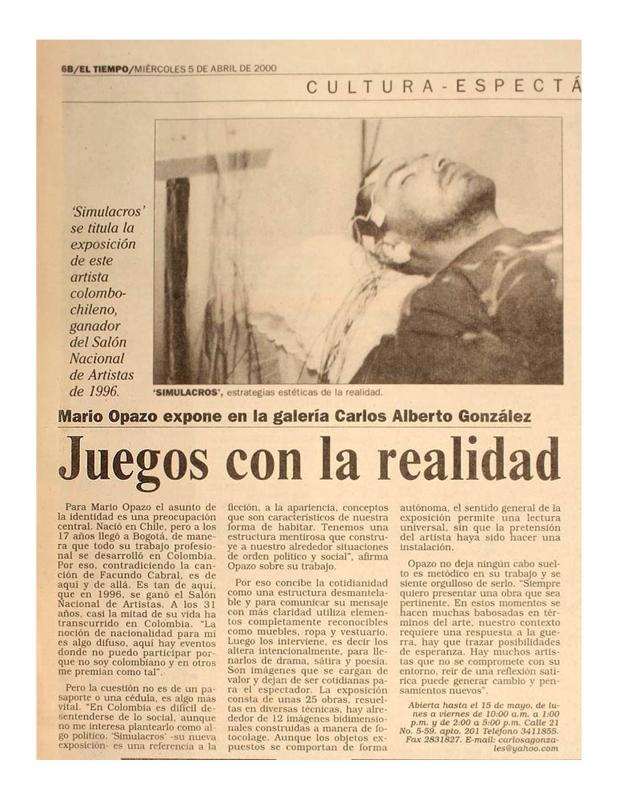This article, written by the artist Mario Opazo (b. 1969), is important because it was one of the first documents to explain his own personal process in detail. The article describes the earliest stage in the development of his sculptural work (that was later known as installation), which was based on drawing and writing; these processes are still (in 2010) part of his visual art discourse. The text of his introduction describes how the installations were received by the media and in Colombian art circles in the early 1990s. As early as 1963 the exhibition Espacios Ambientales [Environmental Spaces] [see doc. no. 868555] sparked debate about works that included objects arranged in the space in question (that were referred to as spatial experimentation), but it was not until the 1990s that the concept of an “installation” was coined. This happened as a result of a change in the way that objects and their materiality were viewed, which altered the relationship between the objects, space, and the viewing public according to the historical charge they possessed. Therefore, the introduction mentioned above refers to Opazo’s work as an “expanding sculpture”; an “unconventional idea” that demonstrated how little installation was understood as a medium in Colombian cultural circles in those days.
In the article, Opazo describes his method, explaining that his process involved three phases in which he worked as a writer, then as a draftsman, and finally as a sculptor. He claims that the third phase led him to create Un planeta para Giselle [A Planet for Giselle] (1995), a project in search of a “virtual space or dimension.” This prompted him to stop working on a two-dimensional plane and to transform his drawings into objects that generated links and tensions among themselves. It is interesting that as the artist explored the literal and an abundance of technological resources he found dangerous elements that, in his opinion, were capable of sullying the communication between the “opposing planes” of objects by arguing that they could produce the “virtual space” for which he was searching. The article shows how Opazo is constantly playing with reality and illusion, key elements that are apparent in some of his later works such as Redundancias [Redundancies] (1995) and Simulacros [Simulations] (2000) [see doc. no. 1132304 and doc. no. 1100788].
Mario Opazo Cartés is a Colombian-Chilean artist; he is a graduate of the fine arts program at the Universidad Jorge Tadeo Lozano (1987). He has taken part in exhibitions such as the 10a Bienal de La Habana [Tenth Havana Biennial] (2009). He is a cofounder and curator of the Festival Experimenta Colombia [Colombia Experiments Festival]. He was awarded first prize at the II Salón de Arte Joven [Second Young Artists Salon] in 1991, and in 1996, the prize at the XXXVI Salón Nacional de Artistas [Thirty-sixth National Artists Salon], among others. He was recently (2010) awarded the Ministry of Culture’s VPremio Luis Caballero [Fifth Luis Caballero Prize] for his installation-performance Expulsión del Paraíso [Expulsion from Paradise].



